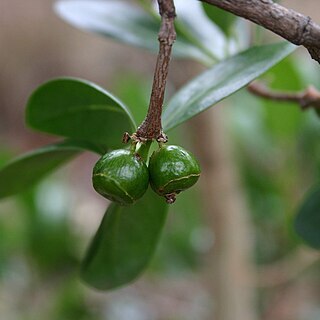Perennial shrub, 3-4 m high. Leaves erect, elliptic to oblanceolate, leathery, glossy above, glabrous to short softly hairy, domatia absent, apex acute, margins entire, with fringe of fine hairs; petioles up to 5 mm long; stipules falling early. Flowers axillary, in few clusters, small. Calyx lobes reduced to a rim. Corolla 4-or 5-lobed, white or yellowish, glabrous. Ovary: style short, exserted. Flowering time Sept.-Nov. Fruit ovoid to almost round, ± 10 mm long, black, with 2 or 3 lobes, crowned with circular scar.
A small evergreen tree. It grows 8 m tall. The crown is dense and rounded. The trunk is thick and corky. The bark is grey and smooth. The leaf nodes are prominent and have tufts of silky hairs. The leaves are opposite and leathery. They are 3-7 cm long by 1-3 cm wide. They are pale or blue-green. The fruit are small and oval. They can be 1 cm long. They have a circular scar around the tip.
Small tree or shrub, 3-6 m high, unarmed. Nodes conspicuously thickened. Bark on older twigs scurfy, cracking in rectangular network, bark on main trunk corky. Leaves elliptic to oblanceolate-obovate, glaucous. Inflorescence axillary, 1-4-flowered cymes; sub-sessile. Corolla tube 2 mm long, lobes 3 mm long. Flowers green.

